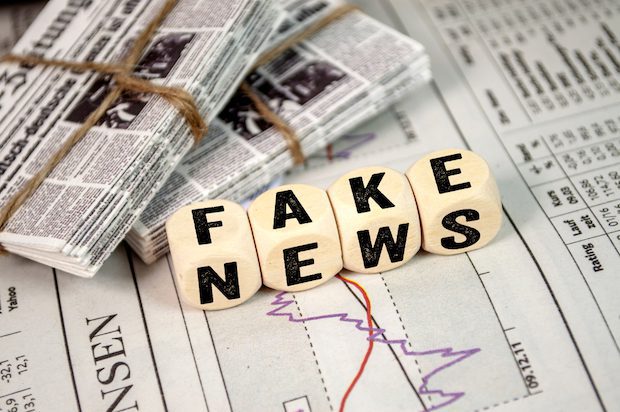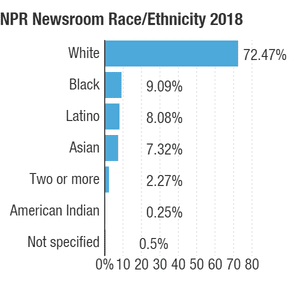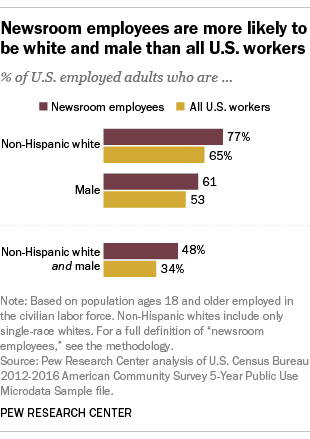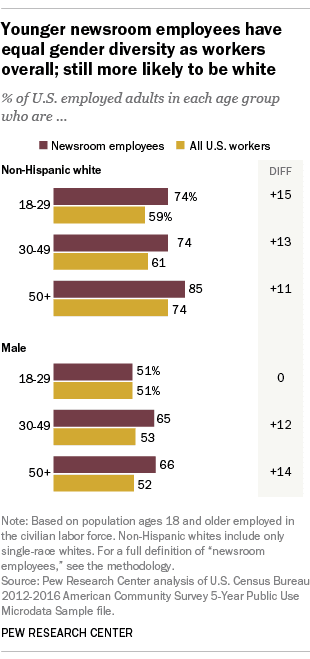Diversity In The Media: Fake News

A reader sends me this from National Public Radio’s ombudsman:

This actually surprised me. I’m an NPR listener (and donor), and it seems like it’s always Diversity Hour. I was driving this week with someone in the car, and as we listened to NPR, I said to my passenger that I rarely hear any stories that have to do specifically with people like me. To be fair, I don’t listen to the news to hear myself reflected back at me; I want to know what’s going on in the world with all kinds of people. But social and religious conservatives are fairly invisible to that newsroom. I know, it’s NPR; what do you expect? Still, it sticks in my craw when news organizations pride themselves on trying to be “diverse,” without the slightest recognition that their definition of diversity is highly selective.
The NPR ombudsman is very concerned about the new diversity numbers:
The numbers also don’t reflect all sorts of other ways that the newsroom could and should look inward as it assesses whether it is staffed appropriately to cover the world. Each year when I post these numbers, for example, I’m asked if NPR specifically tracks the number of employees with physical disabilities, or the number of transgender employees, or the number of employees who self-identify as Arab American. The answer is no.
Does the ombudsman care if NPR tracks the number of newsroom employees who self-identify as observant Christians, Jews, or Muslims? The number of employees who identify as conservative? If not, why not?
I’ve learned to live with the fact that for whatever reason, public radio attracts a disproportionate number of white secular liberals to its ranks. I still listen to it, and support it with my donations as a member of my local station, because I believe that despite its clear biases, public radio provides me with a service I value. Do I think that coverage would improve if there were more people like me in the newsroom? Yes, I do. But I do not want NPR to lower its professional standards to hire subpar conservatives (political or religious) for the sake of meeting some artificial diversity goal. And I don’t take seriously the idea that NPR really wants diversity in its newsroom. If it’s like every other newsroom I’ve worked in, it wants a rainbow coalition of bourgeois secular liberals. In one of my former newsrooms, aside from myself, the only religious conservatives were to be found among African-American secretaries and Hispanic janitorial staff. But if you surveyed our newsroom, you would see a crowd of white, black, Asian, Hispanic, gay and straight educated secular liberals. We were well on our way to achieving Diversity™.
NPR is not all that different from most newsrooms, according to a new Pew report:


Believe me, this causes agony in newsroom management. When I was working in newspapers, every year the ASNE (American Society of Newspaper Editors) would publish results of its membership survey on newsroom diversity. Every year they would find that a disproportionate number of newspaper journalists were white. Oh, the wailing and the gnashing of teeth this caused within the industry! They honestly tried hard to get more ethnic minorities into the newsrooms. I’m not just talking through my hat. I saw this up close and personal. If you were an ethnic minority who wanted to work at a newspaper, you could pretty much write your own ticket, unless you couldn’t write at all.
Still, the numbers stayed the same. Why? Because the number of minority applicants are always disproportionately low. I haven’t looked at numbers recently, but I recall as a newspaper section editor a little more than a decade ago, I read a report showing that far fewer blacks and Hispanics read newspapers than did whites. This is anecdotal, but in my experience, most people who choose journalism as a career grew up in families that subscribed to newspapers, or otherwise paid more attention to the news than average families. The pay is not good in journalism, job security is lousy, and the hours can be terrible. It was like this when I entered the profession in 1989, but it has become much worse over the past 20 years. You have to go into journalism because you have a passion for it. My 12-year-old daughter has a real passion for it, and that genuinely concerns me because I know how unstable the field is.
The NPR ombudsman says in her diversity piece, “Having a diverse newsroom is crucial if NPR wants to tell stories that matter to an increasingly diverse country.” I’ve heard this so many times over my career, and it’s mostly cant. It’s not that she’s wrong. Newsrooms really do benefit from having a wide range of people working there. The cant part is the fact that these people never, ever concern themselves with ideological diversity, or religious diversity. They are secular liberals to the marrow, and they like it that way.
Seriously, it’s true. In 2017, the (left-wing but compulsively honest) media critic Jack Shafer wrote a long piece in Politico talking about how the news media not only lives in an ideological bubble, but also in a geographic one. Excerpt:
The national media really does work in a bubble, something that wasn’t true as recently as 2008. And the bubble is growing more extreme. Concentrated heavily along the coasts, the bubble is both geographic and political. If you’re a working journalist, odds aren’t just that you work in a pro-Clinton county—odds are that you reside in one of the nation’s most pro-Clinton counties. And you’ve got company: If you’re a typical reader of Politico, chances are you’re a citizen of bubbleville, too.
The “media bubble” trope might feel overused by critics of journalism who want to sneer at reporters who live in Brooklyn or California and don’t get the “real America” of southern Ohio or rural Kansas. But these numbers suggest it’s no exaggeration: Not only is the bubble real, but it’s more extreme than you might realize. And it’s driven by deep industry trends.
It’s a really interesting piece that talks about how the rise of Internet journalism has made this problem worse. The problem of media’s ideological monoculture, and how it hurts the profession, cannot be solved by the diversity mentality as it presently exists.
To be fair, if news organizations made a concerted effort to recruit conservatives, they would have a hard time finding qualified candidates. That’s because journalism, for whatever reason, tends to disproportionately attract liberals. I wish that weren’t the case, but there it is. From what I’ve seen in nearly 30 years of working in professional journalism, conservatives who have an interest in the field are usually focused on opinion journalism. I’m generalizing here, and I haven’t been working in a newsroom in eight years, but I haven’t seen a lot of conservatives who are interested in journalism as journalism, journalism as a craft — this, as distinct from journalism as a vehicle for advancing their political interests.
Conservatives love to bitch about media bias, but they are much more reluctant to become journalists. You might say that that’s because they anticipate that the deck will be stacked against them in newsrooms, and there’s something to that. Mostly, though, I think that it’s because the craft of journalism, for whatever reason, tends not to attract conservatives, but it does tend to attract crusading liberals who want to change the world, and are willing to work in a profession where they won’t make much money in order to do it.
My point is that even if news organizations spent as much time and effort trying to recruit conservatives as they do ethnic minorities and women, they would still likely come up short, because the pool of conservatives who are interested in journalism careers is disproportionately small. This kind of variation is normal in human populations. Men are disproportionately interested in STEM fields, and women are disproportionately interested in nursing — and the numbers are not likely to move much. Are there non-racist reasons why blacks and Hispanics are less interested in media careers than whites? Does that question ever get asked?
Think about it: do you honestly think that racism is why the workforce at NPR — NPR! — is so white? Is that really a plausible explanation? Or could it be that that is the only explanation that NPR management, and people like the NPR ombudsman, will accept, because it confirms their prior views about race and society?
Last night I finished Heather Mac Donald’s new book The Diversity Delusion. She writes about how “diversity” has become a pervasive ideology in universities and in corporations. All failures to reach a diversity utopia — e.g., minorities coming up short in testing, institutions failing to fill a pre-set quota for minority employment — are blamed on bigotry. There can be no other explanation. To question the ideology is to reveal yourself as a bigot. The true believers have to delude themselves to make “diversity” a non-falsifiable goal. That is, the kind of socially-engineered egalitarianism that they’re after cannot be unrealistic or unjust in their minds, no matter how hard they have to work to convince themselves that it’s true. If diversity policies do not produce the desired results, then that’s a sign of sinfulness on the part of its implementers; the only acceptable response is to double down, spend more money, hire more administrators, make people attend more training, etc.
I have listened to intelligent people whose minds were conquered by this ideology talk themselves out of seeing what was right in front of their noses, because in their view, seeing what was obviously present in these cases (e.g., a diversity hire could not write) was something bad people did. Diversity could not fail; it could only be failed.
Mac Donald writes below about “implicit bias,” a concept that says that even if you aren’t consciously bigoted, you probably are — and that needs to be fixed. She says:
The iron grip of the implicit-bias concept on the corporate world will merely result in a loss of efficiency as workers are again trundled off to this latest iteration of diversity training and are further pressured to take race into account in personnel decisions. Most ominously for productivity, signatories to the CEO Action for Diversity & Inclusion have pledged to encourage more conversations among their employees about race, even though a recent report found that 70 percent of employees are not comfortable discussing race relations at work—understandably, given the potential tensions created by diversity preferences and the oversaturation of race talk in American life. Procter & Gamble is on the steering committee of the CEO Action for Diversity & Inclusion. You would think that its managers would have better things to do than lead bull sessions about racial microaggressions, in light of the company’s lackluster growth over the last decade and the ongoing fight for control of its board.
I thought the same thing during the 2000s, when newspapers were hemorrhaging readers and profits. Internal diversity obsessions were like rearranging the table settings in the dining room of the Titanic. But that is what the managerial class in journalism cares about more than just about anything. The teachings and rituals of the cult of diversity is a form of secular religion. I came to regard it in part as a way that privileged white liberals worked out their sense of guilt.
When I was working in newsrooms, it was never said, but it was well understood by the few conservatives there, that if you dissented in any way from diversity dogma, you had better keep your mouth shut, or you risked being identified as a racist, sexist, homophobe, etc. Only people like ex-Google employee James Damore, who is on the autism spectrum and struggles to grasp nuances like that, were foolish enough to believe that critical dialogue was possible around these issues. You would stand a better chance trying to convince Torquemada of the virtues of Islam.
I’m not really kidding. Like I said, “diversity,” as they define it, is a religion with these people. Reading Mac Donald’s book, which is full of statistics and real-world stories, is to confront what it means when entire institutions are in the grip of ideology. I’ve said in this space before that readers who grew up under communism tell me that they see the same mentality emerging here, in the liberal West. Read Mac Donald, and you’ll see the kind of thing they’re talking about. These people are going to collectivize the farms, no matter how many kulaks they have to roll over to do it, and no matter how many Soviet people are going to go hungry because the ideology does not correspond to reality.
UPDATE: Reader Jonah R.:
Amusingly, the NPR audience is even whiter than the newsroom. According to recent numbers I just dug up online, 87% of NPR listeners are white, at least 60% of them have a college degree, they’re more than three times as likely as the average American to have attended graduate school, their median household income is nearly $100,000, and they’re most likely to be located in New England or the Pacific states. They are “disproportionately represented in white-collar occupations” and “are more than twice as likely as the average U.S. adult to work in top management.”
The Cliffs of Dover should be so white!
Public broadcasting was established with the explicit goal of providing news and information to under-served poor and minority populations. Instead it’s become a luxury entertainment service for rich, educated white people. It’s one of the most delicious examples of privilege and hypocrisy in the media, and all the reverent stories about Black Lives Matter or the trendy rapper of the moment can’t disguise it.
Ha! Back in the 2000s, when I was at the I was shown some reader data at The Dallas Morning News, I observed that our readership was heavily white, older, and Republican, from north Dallas and the north Dallas suburbs. These were exactly the people that so many of my newsroom colleagues thought were the problem with Texas.
Subscribe for as little as $5/mo to start commenting on Rod’s blog.